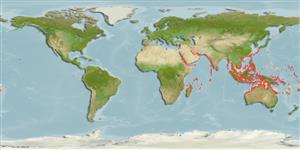>
Syngnathiformes (Pipefishes and seahorses) >
Syngnathidae (Pipefishes and seahorses) > Syngnathinae
Etymology: Trachyrhamphus: Greek, trachys, -eia, -ys = rough + Greek, rhamphos = bill (Ref. 45335).
More on author: Bleeker.
Environment: milieu / climate zone / depth range / distribution range
Ekologi
laut berasosiasi dengan karang; kisaran kedalaman 1 - 42 m (Ref. 1602). Tropical; 32°N - 23°S
Indo-West Pacific: Red Sea and East Africa (Ref. 4281) to New Caledonia, north to southern Japan; Mariana Islands in Micronesia.
Size / Weight / umur
Maturity: Lm ? range ? - ? cm
Max length : 40.0 cm TL jantan/; (Ref. 48635)
deskripsi pendek
Kunci identifiaksi (pengenalan) | Morfologi | Morfometrik
Duri punggung (Keseluruhan (total)) : 0; duri punggung lunak (Keseluruhan (total)) : 24 - 32; Duri dubur: 0; Sirip dubur lunak: 4. Brownish in color, usually with small spots on trunk (Ref. 4281).
Inhabits subtidal lagoon and seaward reefs, usually among algae or seagrasses (Ref. 9710). Most are seen on sand and mud areas, prone to currents; usually soft bottom to about 25 m (Ref. 48635). Ovoviviparous (Ref. 205). The male carries the eggs in a brood pouch which is found under the tail (Ref. 205).
Male carries the eggs in a brood pouch (Ref. 205).
Myers, R.F., 1991. Micronesian reef fishes. Second Ed. Coral Graphics, Barrigada, Guam. 298 p. (Ref. 1602)
Status IUCN Red List (Ref. 130435: Version 2024-1)
ancaman kepada manusia
Harmless
penggunaan manusia
Alat, peralatan
laporan khas
muat turun XML
Sumber internet
Estimates based on models
Preferred temperature (Ref.
123201): 25 - 29.1, mean 28.2 °C (based on 1160 cells).
Phylogenetic diversity index (Ref.
82804): PD
50 = 0.6250 [Uniqueness, from 0.5 = low to 2.0 = high].
Bayesian length-weight: a=0.00037 (0.00016 - 0.00085), b=3.18 (2.99 - 3.37), in cm total length, based on LWR estimates for this (Sub)family-body shape (Ref.
93245).
Trophic level (Ref.
69278): 3.8 ±0.50 se; based on food items.
Daya lenting (Ref.
120179): sedang, Waktu penggandaan populasi minimum 1.4 - 4.4 tahun (Preliminary K or Fecundity.).
Fishing Vulnerability (Ref.
59153): Low to moderate vulnerability (30 of 100).
Nutrients (Ref.
124155): Calcium = 55.7 [31.6, 107.3] mg/100g; Iron = 0.585 [0.354, 1.158] mg/100g; Protein = 18.3 [17.2, 19.4] %; Omega3 = 0.109 [0.066, 0.191] g/100g; Selenium = 37.2 [20.8, 75.0] μg/100g; VitaminA = 68.1 [25.0, 176.6] μg/100g; Zinc = 1.09 [0.77, 1.52] mg/100g (wet weight);
